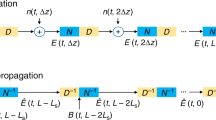Abstract
This paper simulates the relative performance of various artificial intelligence (AI) techniques when applied to nonlinear distortion compensation in wavelength division multiplexing (WDM) optical communication systems. These procedures are less complex than state-of-the-art compensation methods and do not necessitate prior knowledge about the properties of data in neighboring WDM channels, which can be practically challenging. In this study, Neural Networks (NNs) were integrated into both the transmitter and receiver sections of 3- and 5-channel WDM systems, and the resulting enhancement in performance (Q-factor) was assessed across varying levels of fiber nonlinearities. While the NN stage enhances the system performance, the improvement decreases as expected with the channel number and \(\gamma\). Next, two-stage architectures that employ a transmitter side NN together with a classifier at the receiver side were modeled. For the systems examined in this paper simple decision tree structures, boosting, forests, extra trees, and multi-layer perceptron (MLP) classifiers all yielded enhanced system performance compared to simple chromatic dispersion compensation (CDC) with the only exception being Ada boosting which decreased the Q-factor for \(\gamma = 14W^{ - 1} km^{ - 1}\). The outcomes of these investigations show that the most effective performance in highly nonlinear WDM systems is attained by employing two-stage systems, with the incorporation of random forest or extra tree AI methods at the receiver side yielding the highest results.






Similar content being viewed by others
References
Agrawal, G. P.: Nonlinear fiber optics, 4th ed. in Quantum electronics---principles and applications. Elsevier/Academic Press, Amsterdam (2007).
American Association for Artificial Intelligence, Ed., Proceedings / The Twenty-First National Conference on Artificial Intelligence (AAAI-06), Eighteenth Innovative Applications Artificial Intelligence (IAAI-06): Boston, Massachusetts, July 16 - 20 2006. Vol. 1, vol. 1. AAAI Press, Menlo Park (2006).
Bhatia, R.: Investigation of cross-phase modulation-induced crosstalk with sub-planck higher-order dispersion parameters in optical transmission systems. J. Opt. Commun. 42(3), 485–489 (2021). https://doi.org/10.1515/joc-2018-0117
Bhatia, R., Sharma, A.K., Saxena, J.: Performance improvement for N× 80-Gb/s WDM transmission link with optimized alternate polarization. Optik 124(23), 6013–6016 (2013). https://doi.org/10.1016/j.ijleo.2013.04.109
Bhatia, R., Sharma, A.K., Saxena, J.: Comparative investigations of DWDM transmission system with PMD for different orthogonally modulated signals at 80 Gb/s. Int. J. Commun. Syst. 29(6), 1084–1090 (2016a). https://doi.org/10.1002/dac.3076
Bhatia, R., Sharma, A.K., Saxena, J.: Improved analysis of four wave mixing with sub-plank higher-order dispersion parameters in optical communication systems. Optik 127(20), 9474–9478 (2016b). https://doi.org/10.1016/j.ijleo.2016.07.035
Chadha, A., Chadha, A.., Satam, N., Mehta, S., Jagtap, S.: Optimization techniques for 160 GBPS WDM optical links to minimize nonlinear effects. Comput. Eng. Inf. Technol., 06(02) (2017). https://doi.org/10.4172/2324-9307.1000169.
Chiang, T.-K., Kagi, N., Marhic, M.E., Kazovsky, L.G.: Cross-phase modulation in fiber links with multiple optical amplifiers and dispersion compensators. J. Light. Technol. 14(3), 249–260 (1996). https://doi.org/10.1109/50.485582
Chraplyvy, A. R.: Limitations on lightwave communications imposed by optical fiber nonlinearities. In Optical Fiber Communication, New Orleans, Louisiana, p. TuD3 (1988). https://doi.org/10.1364/OFC.1988.TuD3.
Chraplyvy, A.R., Gnauck, A.H., Tkach, R.W., Derosier, R.M.: 8*10 Gb/s transmission through 280 km of dispersion-managed fiber. IEEE Photonics Technol. Lett. 5(10), 1233–1235 (1993). https://doi.org/10.1109/68.248438
Geurts, P., Ernst, D., Wehenkel, L.: Extremely randomized trees. Mach. Learn. 63(1), 3–42 (2006). https://doi.org/10.1007/s10994-006-6226-1
Kingma, D. P., Ba, J.: Adam: A method for stochastic optimization. ArXiv14126980 Cs, Jan. 2017, Accessed: Sep. 08, 2021. [Online]. Available: http://arxiv.org/abs/1412.6980
Liga, G., Xu, T., Alvarado, A., Killey, R.I., Bayvel, P.: On the performance of multichannel digital backpropagation in high-capacity long-haul optical transmission. Opt. Express 22(24), 30053 (2014). https://doi.org/10.1364/OE.22.030053
Melek, M.M., Yevick, D.: Nonlinearity mitigation with a perturbation based neural network receiver. Opt. Quantum Electron. 52(10), 450 (2020a). https://doi.org/10.1007/s11082-020-02565-5
Melek, M.M., Yevick, D.: Machine learning two stage optical fiber nonlinearity mitigation. J. Mod. Opt. 67(12), 1072–1077 (2020b). https://doi.org/10.1080/09500340.2020.1810347
Melek, M.M., Yevick, D.: Fiber nonlinearity mitigation with a perturbation based Siamese neural network receiver. Opt. Fiber Technol. 66, 102641 (2021). https://doi.org/10.1016/j.yofte.2021.102641
Melek, M.M., Yevick, D.: Machine learning compensation of fiber nonlinear noise. Opt. Quantum Electron. 54(11), 685 (2022). https://doi.org/10.1007/s11082-022-04086-9
Shrestha, D.L., Solomatine, D.P.: Experiments with AdaBoost.RT, an improved boosting scheme for regression. Neural Comput. 18(7), 1678–1710 (2006). https://doi.org/10.1162/neco.2006.18.7.1678
Sidelnikov, O., Redyuk, A., Sygletos, S.: Equalization performance and complexity analysis of dynamic deep neural networks in long haul transmission systems. Opt. Express 26(25), 32765 (2018). https://doi.org/10.1364/OE.26.032765
Son, J., Jung, I., Park, K., Han, B.: Tracking-by-segmentation with online gradient boosting decision tree. In> 2015 IEEE International Conference on Computer Vision (ICCV). IEEE, Santiago, pp. 3056–3064 (2015). https://doi.org/10.1109/ICCV.2015.350.
Tao, Z., Dou, L., Yan, W., Li, L., Hoshida, T., Rasmussen, J.C.: Multiplier-free intrachannel nonlinearity compensating algorithm operating at symbol rate. J. Light. Technol. 29(17), 2570–2576 (2011). https://doi.org/10.1109/JLT.2011.2160933
Yaman, F., Li, G.: Nonlinear impairment compensation for polarization-division multiplexed WDM transmission using digital backward propagation. IEEE Photonics J., 2(5), 816–832 (2010). https://doi.org/10.1109/JPHOT.2010.2071860.
Zhang, S., et al.: Field and lab experimental demonstration of nonlinear impairment compensation using neural networks. Nat. Commun. 10(1), 3033 (2019). https://doi.org/10.1038/s41467-019-10911-9
Acknowledgements
The Natural Sciences and Engineering Research Council of Canada (NSERC) is acknowledged for financial support.
Author information
Authors and Affiliations
Contributions
M.M generated the results and wrote the main manuscript text. D.Y supervied the work done and reviewed the manuscript.
Corresponding author
Ethics declarations
Competing interests
The authors declare no competing interests.
Additional information
Publisher's Note
Springer Nature remains neutral with regard to jurisdictional claims in published maps and institutional affiliations.
Rights and permissions
Springer Nature or its licensor (e.g. a society or other partner) holds exclusive rights to this article under a publishing agreement with the author(s) or other rightsholder(s); author self-archiving of the accepted manuscript version of this article is solely governed by the terms of such publishing agreement and applicable law.
About this article
Cite this article
Melek, M.M., Yevick, D. Self-phase modulation nonlinearity distortion compensation in wavelength division multiplexed optical systems. Opt Quant Electron 56, 1070 (2024). https://doi.org/10.1007/s11082-024-07014-1
Received:
Accepted:
Published:
DOI: https://doi.org/10.1007/s11082-024-07014-1




